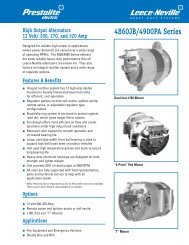Stewart Warner Performance Catalog - Auto Electric Service, Inc.
Stewart Warner Performance Catalog - Auto Electric Service, Inc.
Stewart Warner Performance Catalog - Auto Electric Service, Inc.
You also want an ePaper? Increase the reach of your titles
YUMPU automatically turns print PDFs into web optimized ePapers that Google loves.
Voltmeter vs. Ammeter Fuel Gauge Selection<br />
A voltmeter measures electrical potential (pressure) in units<br />
called volts that is necessary for current<br />
measured in amps (a quantity) to<br />
flow through your electrical system.<br />
If there is NO pressure<br />
(volts), there can be NO current<br />
flow (amps). This is analogous<br />
to having no oil pressure and,<br />
therefore, no oil flow. You must<br />
have one to get the other!<br />
Ammeters were popular when<br />
generators and alternators typically<br />
114200<br />
averaged 35-40 amps of output, and<br />
vehicle electrical systems were much less complex. Today,<br />
alternators commonly have output capacities of 100-110<br />
amps with more complex wiring and higher accessory<br />
loads. This makes it more difficult to install an ammeter.<br />
Just as we measure oil pressure rather than oil flow, we<br />
prefer to measure volts rather than amps, so, the overwhelming<br />
choice for performance applications today is the<br />
voltmeter. In fact, ammeters are not available as a <strong>Stewart</strong><br />
<strong>Warner</strong> <strong>Performance</strong> product, but they are available in our<br />
regular <strong>Stewart</strong> <strong>Warner</strong> line should you need one. Contact<br />
our tech support team if you have additional questions<br />
about ammeters or voltmeters.<br />
The bottom-line...an ammeter is NOT an effective solution<br />
for racing applications!<br />
www.SW-<strong>Performance</strong>.com<br />
WHICH FUEL-LEVEL GAUGE DO I USE FOR MY APPLICA-<br />
TION? <strong>Stewart</strong> <strong>Warner</strong> <strong>Performance</strong> can help you figure<br />
out which gauge to use. Fuel-level gauges, like electric<br />
gauges, are designed to work with specific fuel-level senders.<br />
Each sender is designed with a specific resistive input<br />
range so you must first measure the resistance of your existing<br />
sender.<br />
On the top of your sender,<br />
you’ll find a couple of wires.<br />
Since there are thousands of<br />
combinations for different<br />
vehicles, refer to your<br />
Owner’s Manual or Shop<br />
Manual to determine which<br />
wire is linked from the sender directly to the<br />
gauge. To measure the resistance, disconnect<br />
the plug at the sender and use a digital multimeter set for<br />
Ohms. Connect one lead of the multimeter to the sender<br />
wire and the other lead to the body of the sender (if the<br />
sender is grounded through the fuel tank), or to the ground<br />
wire of the sender (when the sender is not grounded<br />
through the fuel tank). Measure the resistance when the<br />
tank is full, and then again when the tank is empty. Once<br />
you know the resistance range of your sender, refer to the<br />
fuel gauge section of our catalog to find the proper gauge.<br />
Then you can “spec” out the right fuel gauge!<br />
OHMS/RESISTANCE POPULAR MODELS<br />
(EMPTY/FULL)<br />
0-90 Ohms Works on most GM cars, 1965 to<br />
present.<br />
73-10 Ohms Works on Fords prior to 1989 &<br />
most Chryslers.<br />
240-33.5 Ohms Industry standard, works on many<br />
popular cars.<br />
0-30 Ohms Works on most GM cars prior to<br />
1965.<br />
16-158 Ohms Works on most Fords, 1989 &<br />
newer.<br />
37



